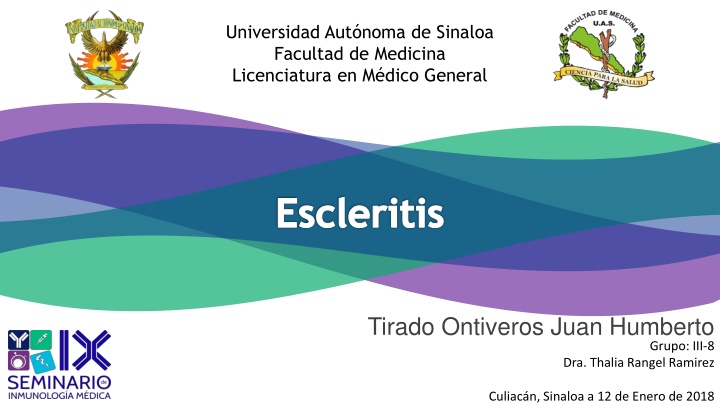
Escleritis: Causes, Symptoms, and Treatment
Explore the comprehensive insights into escleritis, an inflammatory condition affecting the sclera of the eye. Learn about its definition, historical background, epidemiology, etiology, pathophysiology, and immunopathology. Discover the potential associations with systemic diseases, autoimmune conditions, and infections, along with the diagnostic classifications and therapeutic considerations. Gain valuable knowledge to understand the complexity of escleritis and its implications on ocular health.
Download Presentation

Please find below an Image/Link to download the presentation.
The content on the website is provided AS IS for your information and personal use only. It may not be sold, licensed, or shared on other websites without obtaining consent from the author. If you encounter any issues during the download, it is possible that the publisher has removed the file from their server.
You are allowed to download the files provided on this website for personal or commercial use, subject to the condition that they are used lawfully. All files are the property of their respective owners.
The content on the website is provided AS IS for your information and personal use only. It may not be sold, licensed, or shared on other websites without obtaining consent from the author.
E N D
Presentation Transcript
Universidad Autnoma de Sinaloa Facultad de Medicina Licenciatura en M dico General Escleritis Tirado Ontiveros Juan Humberto Grupo: III-8 Dra. Thalia Rangel Ramirez Culiac n, Sinaloa a 12 de Enero de 2018
DEFINICIN Se define como proceso inflamatorio que afecta a la esclera . Cr nico Doloroso Destructivo Causante potencial de ceguera
ANTECEDENTES HISTRICOS Se han propuesto muchas clasificaciones de la enfermedad escleral (Holthouse, I893; van der Hoeve, 1934; Franceschetti y Bischler, I950; DukeElder y Leigh, I965; Sevel, I967) , en 1976 Watson y Hayreh clasificaron la escleritis en Anterior : Difusa , nodular , necrotizante con y sin inflamacion . posterior Escleritis posterior Escleritis nodular
EPIDEMIOLOGA 57% asociado a enfermedades sist micas 50% inflamatoria y 7% infecciones 30% asociado a artritis reumatoide 30-60 a os Mujeres 2:1 HLA-B27 6casos por cada 100.000 personas
ETIOLOGA Vasculitis sist micas Enfermedades de tejido conectivo Artritis reumatoide Artropat as seronegativas Artritis cr nica juvenil S ndrome de Reiter Lupus eritematoso sist mico Granulomatosis de Wegner Poliarteritis nodosa Arteritis de c lulas gigantes S ndrome de Behcet Takayasu Enfermedades neurocut neas Porfiria Ros cea Enteropat as enfermedad de Crohn Colitis Ulcerosa Enfermedades infecciosas S filis Tuberculosis Enfermedad de Lyme Varicela zoster
FISIOPATOLOGA Perdida del patr n radial de los vasos sangu neos epiescler ticos volvi ndose tortuosos, lo cual favorece la aparici n de edema e hiperemia escleral Eritema ocular, pr cticamente en la totalidad de la escler tica. Aumento en la presi n ocular
INMUNOPATOLOGA Incluye infiltraci n del tejido escleral con c lulas inflamatorias como Neutr filos Macr fagos C lulas T y B Los fibroblastos estimulados producen enzimas degradantes Hipersensibilidad tipo III - Activaci n del complemento. - Complejo de ataque de membrana con acci n local de citosinas, factor de necrosis tisular alfa (TNF-alfa) e interleucinas-1 (IL-1)
MANIFESTACIONES CLNICAS Sensibilidad a palpaci n de globo ocular Edema escleral. Fotofobia Epifora. Disminuci n de la agudeza visual Parches rojos en la parte normalmente blanca del ojo
DIAGNSTICO fenilefrina 10% Ecograf a ocular para evaluar la parte posterior de la escler tica que no es visible por exploraci n f sica. 0 Administraci n de gotas de adrenalina o fenilefrina Biomicroscop a del segmento anterior Medici n presi n intraocular Valoraci n de fondo de ojo bajo midriasis farmacol gica 1+ leve m nimo indicio 2+ 3+ 4+ moderada grave necrotizante
TRATAMIENTO Y CONTROL Nombre de Medicamento Dosis Clase de f rmaco Tratamiento 100 mg cada 8 horas Inicial (administraci n v a oral, tratamiento paliativo para el dolor) Los esteroides representan una opci n de manejo inicial en escleritis necrotizante y no necrotizante, Ibuprofeno 50 mg cada 12 horas AINES Indometacina (Antiinflamatorios no esteroideos). 100 mg cada 8 horas Naproxeno La inyecci n subconjuntival o subtenoniana de esteroides representa una opci n terap utica en casos de escleritis no necrotizante ni infecciosa, Segunda elecci n (se administran en forma de gotas oftalmol gicas) 5 mg en gotas cada doce horas Prednisona Corticoesteroides Dexametasona 3,5 mg en gotas cada 12 horas
BIBLIOGRAFA Kanski J. , Bowling B.. Oftamologia clinica 7 . Espa a: Elselvier S.A;2012 Maza M. The schlera 2 ,New York: Springer ; 2012 Arponen S .Web consultas [internet] 2016 [ diciembre 2017].Disponible en : https://www.webconsultas.com/salud-al-dia/escleritis/tratamiento-y-prevencion-de-la- escleritis Lusby F. .Medlineplus [internet]. 2016 [diciembre 2017]. Disponible en: https://medlineplus.gov/spanish/ency/article/001003.htm Roat M. . Manual MSD [internet].2016 [diciembre 2017]. Disponible en : http://www.msdmanuals.com/es-mx/professional/trastornos-oft%C3%A1lmicos/trastornos- conjuntivales-y-esclerales/escleritis Cenetec.Diagnnostico Y Tratamiento De Escleritis [internet]. Mexico :Centro Nacional De Excelencia Tecnologica En Salud;2015[diciembre 2017].Disponible En :http://www.cenetec.salud.gob.mx/descargas/gpc/CatalogoMaestro/IMSS-738-15- Escleritis/738GRR.pdf Frutos I., Valdes A. , Prada C. , et.all. Escleritis Posterior : A Proposito De Un Caso.RCO.2014;27(3):497-502.
